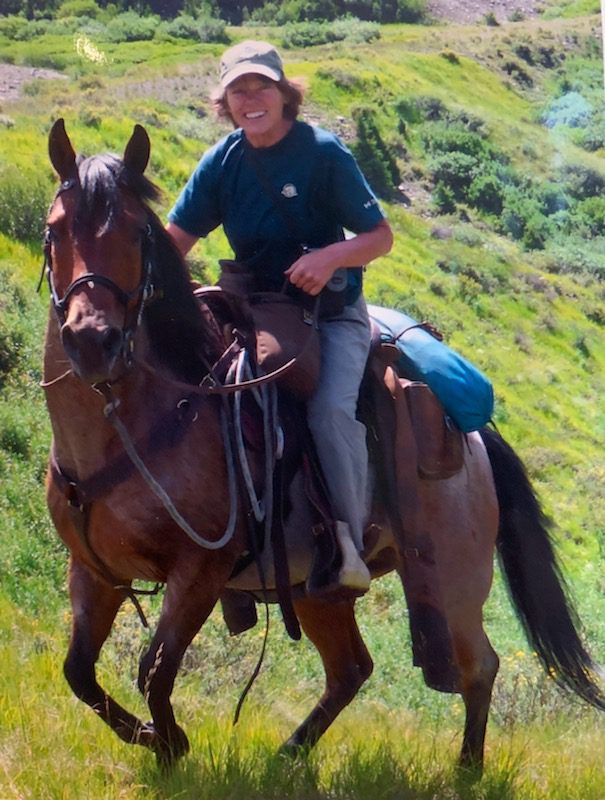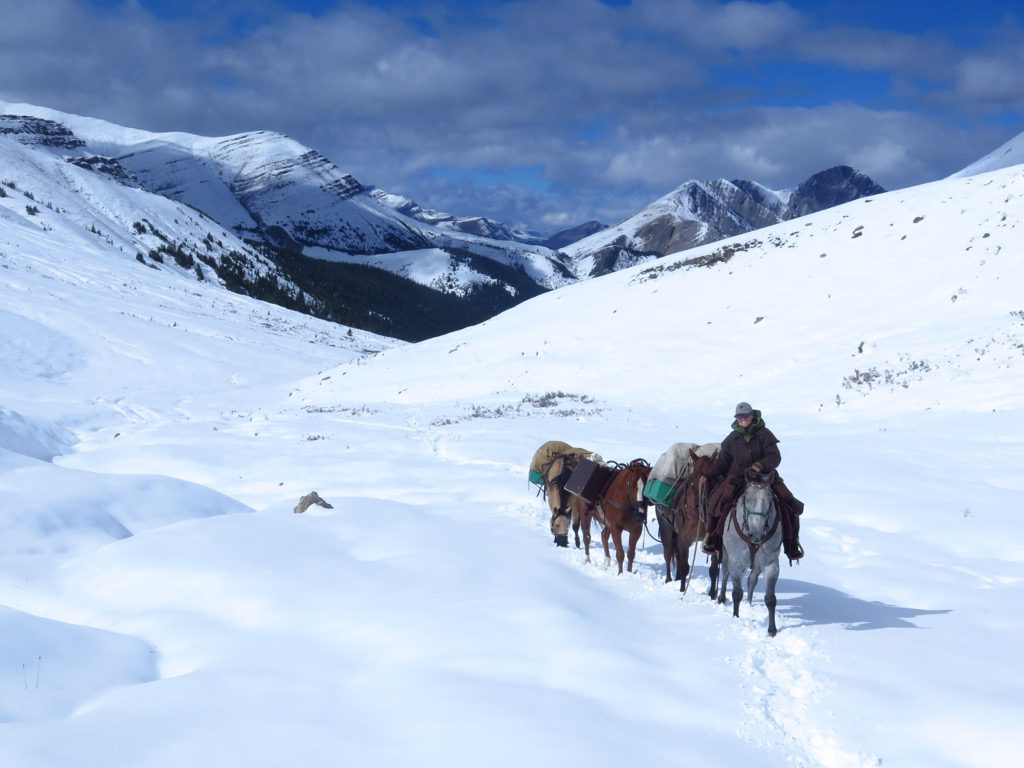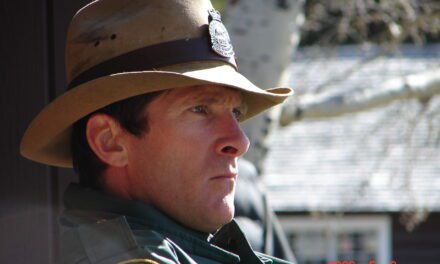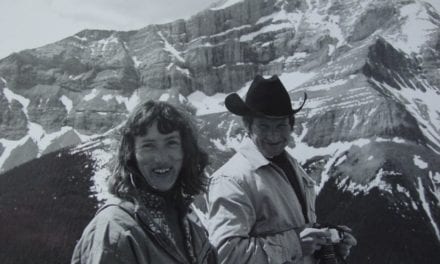Park Warden Alumni Society of Alberta
Oral History Phase 13 Fall 2023
Phone Interview with Julie Timmins
Date/time October 25, 2023
Interviewed by Monique Hunkeler

Julie On Vaquero Cascade Fireroad 2019
Place and date of birth?
JT: I was born in 1955 in Toronto, Ontario
MH: Where did you grow up?
JT: I grew up in Thornhill, Ontario, which was rural to Toronto during that time and of course Thornhill has now been absorbed into the city. I had the good fortune of being in a family where skiing and horseback riding were our things, which seemed to fit in nicely with the direction I was moving in my career.
MH: How did you become involved in the Warden Service? Which national park did you start working in?
JT: Well, I first came out west in 1976, between university semesters in Ontario, and I just knew that the mountains were going to be my future. I went to the University of Waterloo (’74-’79) and my degree was in human kinetics and leisure studies. After a few years in Alberta, I returned to Ontario in 1982-1983 to get my BEd. at Queen’s majoring in Geography and Environmental Science.
After graduating in 1979 I came to Alberta and ski patrolled a bit and then I landed a job with B.C. parks, which I did from 1982 to 1988, working as a Park Ranger in the Bugaboos and Assiniboine. During my time with B.C. Parks, I learned about the Warden Service. In 1989 I applied to the Warden Service and got a job in Banff National Park. I got married that year and it didn’t work out very well to try working in different parks. So, Banff was basically where I spent my career with National Park.
MH: What made you want to join the Warden Service?
JT: Part of it was the complexity of the job, the multitude of different functions and tasks. Plus, it offered longer employment at that time than what I would get from B.C. Parks. And so there was a few people that influenced me in pursuing that job and I was really excited to get it.
MH: What different parks did you work in? How did they compare? Do you have a favourite?
JT: I didn’t get to work in other parks. I visited many of the national parks across the country and love them all. They’re all beautiful. But I think there was a special feeling of being embraced by the mountains here in Banff. I knew the mountains encompassed beautiful alpine meadows, lakes and spectacular peaks.
MH: What were some of your main responsibilities over the years?
JT: During my first 20 years, before the law enforcement branch was created, our responsibilities were focused on Law Enforcement, Resource Conservation and Visitor Safety. Our positions varied from year to year and you could either be assigned to the backcountry or the frontcountry. Each has different responsibilities. I would say that patrolling in the backcountry was something I really loved to do and I loved working with the horses. I felt quite a unity with the horses in the landscape and quite at home when I was out there. Back country in Banff included the Egypt Lake district, the south end of the park, the north end of the park. With young kids at home, it was more difficult to spend a lot of time in the backcountry, but Egypt Lake fit in quite nicely with having kids. At those times the kids could come in and visit, as long as they came in with another adult. But my understanding is that kids aren’t welcome anymore at backcountry cabins. I just think that backcountry assignments were great and engaging with the public was a lot of fun. I spent several years assigned to Egypt Lake. Checking permits also included a couple of hours going over maps with hikers and discussing and various routes … something I loved to do. They often wanted to pick my brain about other destinations so great interactions.

Julie on Divide Pass 2020

Julie at Scotch Camp
Egypt lake was a hiking district during my time there as horse use was not permitted. There was a day when horse use in the Egypt Lake area was prolific. Healy Pass, Whistling Pass, Redearth Pass, Ball Pass were all part of the Warden’s horse patrols. I think it was in 1980 when the sunshine meadows trail went in and a decision was made to ban horses in order to protect the Healy Meadows.
I did, in the early days, try taking horses up Redearth Creek to get supplies to the cabin. This worked pretty well, but horses wouldn’t stay up there. I think that was historical. Even when Scott Ward was there, horses tended to migrate back down Redearth Creek. Anyway, I had them up there a couple of times and had to keep them in the corral. As time went on, the bridges up Redearth Creek were not designed for horses. And it was quite tricky getting them up there.
MH: What did you like / Dislike about being a warden? 0703
JT: Well, I liked the camaraderie within the Warden Service. I loved the job and thrived with a large variety of assignments and tasks. I think working for the Warden Service was really kind of a gift. And for a lot of us, it was a lifestyle. And we knew each other and we knew what was happening in every function. And it just was kind of a wonderful place to be in.
MH: Didn’t like?
JT: I would say that it was the shift from working under one umbrella, Resource Conservation, Public Safety and Law Enforcement to working under one umbrella. When the Law Enforcement Branch was fully developed you were either in Resource Conservation, Law Enforcement, or Visitor Safety. And that sort of affected the camaraderie within the group, and it was just difficult. I enjoyed doing the Law Enforcement that we did, and lots of training in Law Enforcement and Resource Conservation and Visitor Safety, which was really pretty darn good. And it was difficult letting go of the Law Enforcement and Visitor Safety as we evolved into Resource Conservation Officers. Regardless of the split, I was passionate about preserving the park ecosystems for future generations, and working in ecological integrity was a way of monitoring the various ecosystems within the park and the wildlife populations.
MH: What were some of your more memorable events as a Warden? 09:05
JT: Well, it’s pretty memorable, the difficulty in the transition from being a Park Warden to the new Park Warden Service and readjusting to that new position. I worked as a Park Warden for the first 20 years into my career but for my last 12 years I was a Resource Conservation Officer. If I was working in the backcountry as a Resource Conservation Officer and saw a law enforcement infraction it seemed ridiculous that I had to call it in and Law Enforcement would have to decide if they were going to fly out and deal with it or not. So that was sort of a difficult time.
But memorable! I had so many memorable times out there with my numerous patrolling partners to horse antics! Learning the landscape inside out was an adventure.
MH: Can you tell me about any rescue/wildlife stories that stick out in your memory? 1010
JT: Well, I’m just trying to think of those because there was so many and where do you start and where do you finish? At the time I was patrolling the backcountry the growth of emergency personnel locators (InReach and Spot) meant many wildlife incidents in the backcountry were something we only heard about over the radio. Before the popularity of these devices’ backcountry wardens would respond to events as fast as they could.
One memorable event was in Egypt Lake when it was reported to me that there was a dead moose on the way to Verdant Creek, on the west side of Redearth Pass. I investigated and found a young moose, maybe in its second year, that the wolves had killed. Some of it was consumed, but there was a lot of moose left. I can remember talking to Banff, saying maybe this animal should be flown out because it was near the water supply and on a popular trail. I was told to estimate how much it weighed and I had no idea, so I was told to just cut it up and haul it away. I had a friend with me on that trip so we put on coveralls, sharpened a few knives, and cut off the legs, the head and other parts. Mainly the stuff that was eaten were the contents in the stomach and the chest cavity. It was beyond belief that I had to do this, but my friend and I lugged those heavy pieces of legs and other body parts up into the bush. Finally, we got all the moose parts up a bank and back into a meadow, away from the trail and I laid it out exactly how it should have looked when it was all put together with joints and stuff. And the next week, I went there and I crept up over the hill hoping there was no bear feeding on the carcass and it was exactly the way I’d left it. And then two weeks later, I went up and snuck up again and sort of peered in hoping there was nothing around, and the whole thing was gone. I guess the wolves had gone back up, found it and finished it off. But yeah, there was wolf activity up in Egypt Lake area and they were all collared so you could tell that the wolves had been up there.

Julie carving up moose Carcass Egypt Lake area

Perfectly re-aligned moose carcass Egypt Lake area
Lots of visitor safety training. Rescues, I was involved in several, but I can’t think of anything that was really a serious, multi day involvement that I was involved in. There was the general call out to sling in and help someone or to recover a body, but in terms of multi day rescues, I hadn’t really been involved in any of those.
MH: How did the Warden Service change over the years? 1509
JT: The change to a Law Enforcement Branch resulted in changes in how we patrolled the backcountry. Backcountry travel has since become task oriented related to resource conservation concerns, ecological integrity projects, fire and veg or aquatics. Prior to the creation of the Law Enforcement branch, we cleared trails, helped maintain facilities, did surveys, boundary patrols, law enforcement and visitor safety. Backcountry shifts are now short. The nice thing about the old 9-day shift, you always had time to deal with bad weather days. I think that because there’s so many different functions, and not a lot of cross-over, that the camaraderie wasn’t the same in the office, which had been a pretty special thing. And quite often, I found that one function didn’t have a clue what the other function was doing. And I did, under a certain leadership, get the opportunity, when I was a Resource Conservation Officer to go and help with aquatics and do some E fishing (electro fishing) and go to some camps with Charlie Pacas, Jim Murphy and Mark Taylor. And that was really nice way to learn about the aquatic ecosystem and be in the mountains. And doing the fish surveys and getting rid of non-indigenous species, things like that. I just think there was sort of a gap, and it’s not the same, it’s this function or that function, and there’s not really the same crossover in so many ways.




Thanks for sharing, great times with the old Warden Service.
Bob Thexton
CPW Kejimkujik (ret’d)